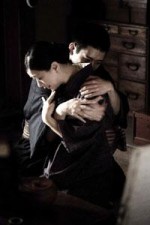The other side of battle

After tackling the issues of child abuse and euthanasia in Mystic River and Million Dollar Baby, legendary actor/director Clint Eastwood decided to tackle the biggest and most troubling issue of all.
In Letters from Iwo Jima, he set out to demonstrate the tragic absurdity of war, as well as elucidate the differing cultural perceptions that arise when two nations enter battle.
Whereas Eastwood’s Flags of Our Fathers – which serves as a companion piece to Letters – depicts the American perspective on the Battle of Iwo Jima, this film remains reverently focused on authentically recreating the Japanese experience during the battle. Academy Award nominee Ken Watanabe (The Last Samurai) leads a remarkable cast as Tadamichi Kuribayashi, a conflicted general forced to lead his troops against U.S. forces in the crucial World War II battle.
While the first 40 minutes of Letters are rather uneventful, Eastwood uses this opportunity to establish an emotional connection between the characters before the Americans invade. During this period, the film chronicles the dissension between the Japanese soldiers as they argue the appropriate strategy to prepare for the American assault on Iwo Jima.
Once the battle begins, the film delivers one emotionally taut sequence after another as the situation becomes more complicated. Soon, the Japanese soldiers realize their imminent defeat and must decide whether to die honorably or continue fighting until the end.
The film is a visual poem fraught with symbols – especially the eponymous letters the Japanese soldiers write to their families. Eastwood uses this motif to emphasize the loss of life incurred by the battle and the needlessness of such sacrifices, essentially deriding the very concept of war itself.
Likewise, Kuribayashi’s prized revolver, which is the subject of mystery throughout much of the film, comes to represent the deterioration of civility between the United States and Japan – two powerful and honorable nations thrust into combat.
In order to further extend these themes, Eastwood employs the use of flashbacks to provide viewers with greater insight into the characters as these scenes sharply contrast the carnage at hand.
A masterful filmmaker, Eastwood has undertaken an admirable task in attempting to accurately and realistically depict the Japanese side of the Battle of Iwo Jima. Although the film initially portrays the Americans as the enemy, Letters ultimately reveals that both nations are essentially the same. Though they are in the middle of a battle, both Japanese and American forces exhibit equal measures of kindness and cruelty toward their enemies, creating a far more balanced approach than is usually afforded films of this genre.
Using the Battle of Iwo Jima as a springboard to examine the futile nature of war, Eastwood’s masterpiece seeks to provide American audiences with a fresh perspective on the battle and the cultural differences that cause misconceptions between nations. As the film demonstrates, such preconceived notions often result in fear, hostility and, inevitably, conflict. Nominated for four Academy Awards – including best picture – Letters from Iwo Jima exposes the sad fact that, when it comes to war, nobody truly wins.
Grade: A-
Rated: RRunning time: 141 mins.







